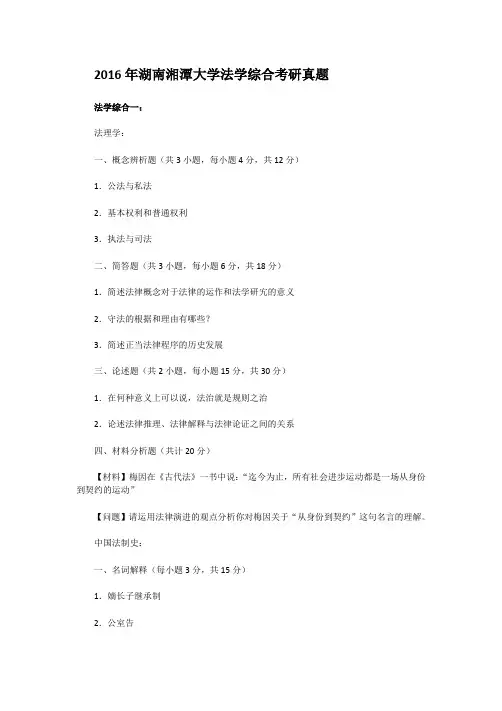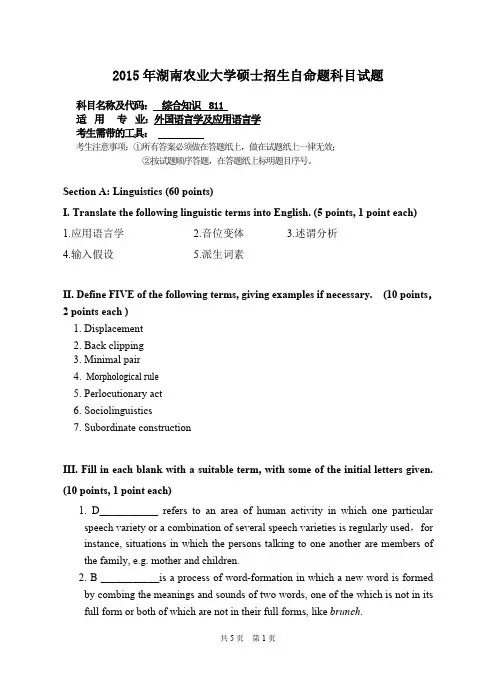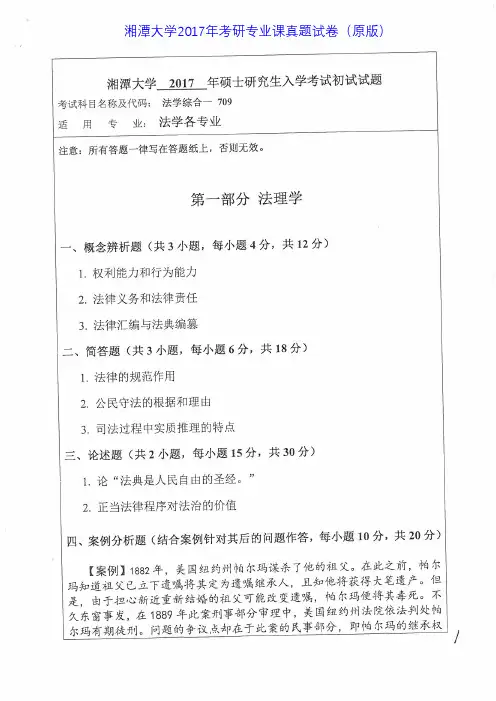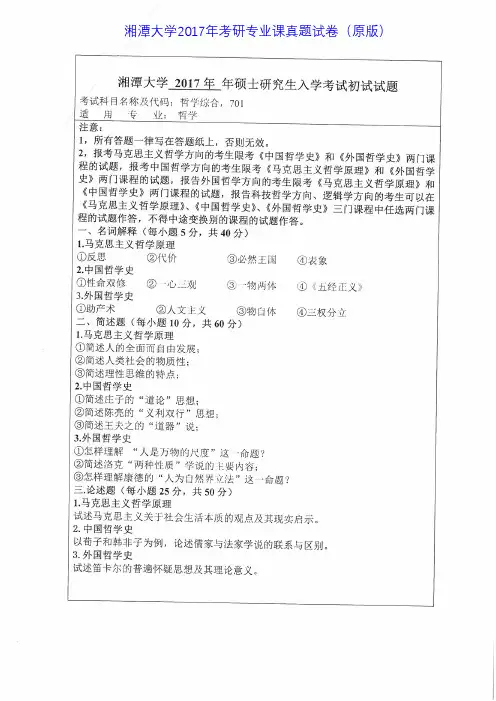湘潭大学考研试题831日语语言文学综合知识2016年-2017年
- 格式:pdf
- 大小:2.02 MB
- 文档页数:7

2016年湖南湘潭大学法学综合考研真题法学综合一:法理学:一、概念辨析题(共3小题,每小题4分,共12分)1.公法与私法2.基本权利和普通权利3.执法与司法二、简答题(共3小题,每小题6分,共18分)1.简述法律概念对于法律的运作和法学研宄的意义2.守法的根据和理由有哪些?3.简述正当法律程序的历史发展三、论述题(共2小题,每小题15分,共30分)1.在何种意义上可以说,法治就是规则之治2.论述法律推理、法律解释与法律论证之间的关系四、材料分析题(共计20分)【材料】梅因在《古代法》一书中说:“迄今为止,所有社会进步运动都是一场从身份到契约的运动”【问题】请运用法律演进的观点分析你对梅因关于“从身份到契约”这句名言的理解。
中国法制史:一、名词解释(每小题3分,共15分)1.嫡长子继承制2.公室告3.义绝4.枷号5.“五五完草”二、试论春秋时期成文法的公布。
(10分)三、试述清末司法机构的改革及其意义。
(10分)宪法学:—、名词解释(每小题3分,共12分)1.不成文宪法2.原始国籍3.行政区划4.部门规章二、简述题(每小题5分,共15分)1.简述现行宪法关于非公有制经济基本政策的主要内容。
2.简述我国设区的市级以上人大代表选举的选区划分标准。
3.简述中国国务院总理负责制的主要内容。
三、法条应用题(8分)某设区的市的人大常委会于2015年8月制定了一部名为《某某市生猪养殖税征收条例》的地方性法规,请根据《中华人民共和国立法法》的规定判断该行为的合宪性。
法学综合二:民法总论:一、辨析题(辨别下列说法对错,并简要说明理由。
每题3分,共12分)1.一用餐客人未付饭钱即想离开饭馆,饭馆服务员见状揪住他不让走,并打报警电话。
客人说“你不让我走还限制我自由,我要告你们饭馆”。
饭馆的行为构成侵权。
2.甲有闲置房间两间,甲、乙双方在房屋租赁合同中约定,如果甲的儿子大学毕业回家工作,乙立即将该房退还给甲。
这里的“甲的儿子大学毕业回家工作”是该房屋租赁行为所附的延缓条件。

2015年湖南农业大学硕士招生自命题科目试题科目名称及代码:综合知识 811适用专业:外国语言学及应用语言学考生需带的工具:考生注意事项:①所有答案必须做在答题纸上,做在试题纸上一律无效;②按试题顺序答题,在答题纸上标明题目序号。
Section A: Linguistics (60 points)I. Translate the following linguistic terms into English. (5 points, 1 point each)1.应用语言学2.音位变体3.述谓分析4.输入假设5.派生词素II. Define FIVE of the following terms, giving examples if necessary. (10 points,2 points each )1. Displacement2. Back clipping3. Minimal pair4.Morphological rule5. Perlocutionary act6. Sociolinguistics7. Subordinate constructionIII. Fill in each blank with a suitable term, with some of the initial letters given.(10 points, 1 point each)1. D___________ refers to an area of human activity in which one particularspeech variety or a combination of several speech varieties is regularly used,for instance, situations in which the persons talking to one another are members of the family, e.g. mother and children.2. B ___________is a process of word-formation in which a new word is formedby combing the meanings and sounds of two words, one of the which is not in its full form or both of which are not in their full forms, like brunch.3. H___________ structure is the sentence structure that group words into structuralconstituents and shows the syntactic category of each structural constituent, such as NP, VP and PP.4. M__________ is the branch of grammar that studies the internal structure ofwords, and the rules by which words are formed.5. C _________are those illocutionary acts whose point is to commit the speaker tosome future course of action.6. T___________ theory is a theory about trace left by movement. This theoryassumes that a moved constituent leaves behind a phonologically null element in its original site.7.P___________ are sentences that do not state a fact or describe a state and are notverifiable, in other words, they are utterances that perform an act.8. I___________ is the language system of an individual as expressed their way heor she speaks or writes within the overall system of a particular language.9. S___________ is the study of meaning communicated through language. Thebasic task is to show how people communicate meanings with pieces of language.10. A _________ phonetics studies the movement of the vocal organs of producingthe sounds of speech.IV. Decide whether each of the following statements is true or false. Write T for true and F for false. (15 points,1.5 points each )1. ()Duality is one of the characteristics of human language. It refers to the factthat language has two levels of structures: the system of sounds and thesystem of meanings.2. ()Saussurs’s exposition of synchronic analysis led to the school of historicallingusitics.3. ()Chomsky’s concept of linguistic performance is similar to Saussure’sconcept of parole, while his use of linguistic competence is somewhatdifferent from Saussure’s langue.4. ()If language learners are provided with sufficient and the right kind oflanguage exposure and chances to interact with language input, they willacquire the native-like competence in the target language.5. ()Syntactic category refers to all phrasal syntactic categories such as NP,VP,and PP, and word-level syntactic categories that serve as heads of phrasal syntactic categories such as N and V.6. ()Competence and performance refer respectively to a language user’sunderlying knowledge about the system of rules and the actual use of language in concrete situation.7. ()Two sentences using the same words may mean quite differently.8. ()Hyponymy is a matter of class membership, so it is the same as meronymy.9. ()Inviting, suggesting, warning, ordering are instances of commissives.10. ()The right ear advantage(REA)is true to no matter whether people havethe left hemispheric dominance for speech or the less common right hemispheric dominance for speech.V. Choose FIVE of the following questions to answer. (20 points,4 points each)1. Who put forward the concept of langue and parole? What is the differencebetween them?2. To what extent is phonology related to phonetics and how do they differ?3. Decide which way of word formation is used to form the following words.Motel lase ROM mew/miaow4. What is word? What is lexicon? What is lexeme? What is vocabulary?5. Can you make some comments on IC analysis?6. What is X-bar theory?7. What is discourse analysis?Section B: Translation (60 points)1.Translate the following into Chinese (30 points)The sublime paradox of the spiritual life is repeated in all true development of personal gift and power. In order to find his life a man must first lose it; in order to keep his soul a man must first give it. The beginning of all education is self-conscious; at the start every effect must be calculated, every skill, method, or dexterity carefully studied. Training involves a rigid account of oneself based on searching self-knowledge. To become an effective speaker one must know his defects of bearing, gesture, voice; one must bring his whole personality into clear light, and study it as if it were an external thing; one must become intensely self-conscious. The initiation to every art is through this door of rigid scrutiny of self and entire surrender of self to the discipline of minute study and exacting practice. The pianist knows the artistic value of every note, and strikes each note with carefully calculated effect. The artist gives himself up to a patient study of details, and is content with the monotony of laborious imitation; subjecting every element of material and manner to the most thorough analysis.The first stage in the education of the true worker is self-conscious; the final stage is self-forgetful. No man can enter the final stage without passing through the initial stage; no man can enter the final stage without leaving the initial stage behind him. One must first develop intense self-consciousness, and then one must be able to forget and obliterate himself. One must first accept the most exacting discipline of the school, and then one must forget that schools exist. The apprentice is the servant of detail; the master is the servant of the idea: the first accepts methods as if they were the finalities of art; the second uses them as mere instruments. Tennyson's attention was once called to certain very subtle vowel effects in one of his later poems; he promptly said that he had not thought of them. That was undoubtedly true, for he had become a master; but there was a time, in his days of apprenticeship, when he had studied the musical qualities and resources of words with the most searching intelligence. The transition from apprenticeship to mastery is accomplished when a man passes through self-consciousness into self-forgetfulness, when his knowledge and skill become so much a part of himself that they become instinctive. When the artist has gained, through calculation, study, and, practice, complete command of himself and his materials, he subordinates skill to insight, and makes his art the unconscious expression of his deepest nature. When this stage is reached the artist can pour his whole soul into his work almost instinctively; his skill and methods have become so completely a part of himself that he can use them almost without being conscious of them.2.Translate the following into English. (30 points)“诺诺”者,唯命是从,凡事好好好,是是是,逢人点头哈腰,遇事不辨青红皂白,正所谓“唯唯诺诺”。


